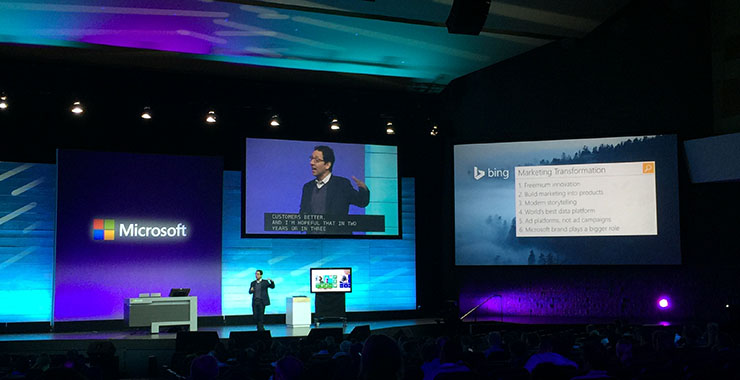
6 keys to marketing transformation from Convergence 2015
If the first portion of Day 1 of Convergence was about technology empowering people, CMO Chris Capossela’s general session focused more on people empowering people in the context of marketing transformation – lessons, mistakes, and best practices. As Capossela put it, “there are things that go far beyond technology”.
Capossela defined marketing transformation along six key themes that have been foundational for Microsoft’s marketing transformation over the past 18 months.:
- Freemium innovation
- Build marketing into products
- Modern storytelling
- World’s best data platform
- Ad platforms not campaigns
- Microsoft brand plays a bigger role
Freemium innovation
According to Capossela, freemium versions of products give users opportunity to fall in love with a product—a functional, permanent version, not a demo—that also has a monetized level. All Microsoft products will have a free tier – not a trial – used to acquire users to engage, enlist, and, ultimately, monetize.
For example, Office 365 launched this year for free on screens below 10.1” and for a fee for screens above 10.2”, a seismic shift from the way Office used to be marketed. In less than a year, Office 365 was downloaded onto 40M small devices. For comparison, 70-75M copies of Office are sold per year. Given the level of awareness and rapid user acquisition, Capossela expects to invest the most marketing spend on engaging users rather that user acquisition.
On the commercial side, Power BI has launched with a free version of the business analytics product that enables users to share dashboards with others outside their organization. The basic tier of service is available for free to build a network effect with broader capabilities in the paid version.
Build marketing into products
Along the message of investing more marketing spend in user engagement, a key learning Capossela covered was building marketing into products. While marketing dollars spent around engagement can be effective, product design is far more effective at getting people to be deeply engaged in products.
This strategy aligns with selling an ecosystem over individual products – another example Capossela listed was the Surface Pro 3 pen. During product development, the Surface team worked hand in hand with Windows and OneNote in order to design functionality where tapping the Surface with the Surface Pro 3 pen automatically opens OneNote. “Surface Pro 3 is now my best vehicle for getting OneNote users,” Capossela said.
On a similar note, integration of Cortana into Windows 10 converts Cortana users into Bing users. While it’s ordinarily hard to convince users to switch from Google to Bing, close product integration of Bing into Windows has the benefit of a seamless user experience versus head-to-head competition.
Modern storytelling
From the perspective of modern storytelling, Capossela covered two concepts: focus amidst increasing marketing complexity and partnering with technology.
Capossela warned against the temptation to tell stories on every channel: 140 characters on Twitter, 12 minute TED talks, conference keynotes to 12K attendees. “The challenge I have at Microsoft is people want to tell tons of stories, everywhere they can possibly tell,” he said. Each channel and format requires different skills to be effective.
Lennart Boorsma, from Heineken Global Marketing, and Ewout Barendregt, Manager of the Global Centre of Excellence Marketing, joined Capossela on stage to discuss how they partner marketing with technology to drive the business.
Their sponsorship of 6 James Bond movies resulted in a campaign spanning 90 markets and 36 languages that invited the consumer to play a role in the Bond world. From a technology perspective, the experience had to be landed in a specific way for each country in a way that respected personal identifying information regulations.
World’s best data platform
“We’re blind if we don’t have a great data platform,” Capossela said, underscoring the strategic importance of data to his marketing organization. “The product I am using the most at Microsoft, outside of Outlook, is Power BI.”
Capossela’s approach to data involves combining behavioral data, meaning metrics around product usage like DAU and MAU, and attitudinal data, meaning how happy a customer is with a product. “That’s what lets me start to calculate what a fan looks like,” he said.
Ad platforms, not ad campaigns
Allison Watson, CVP of US Marketing & Operations, joined Capossela to give a day-in-the-life perspective of how she and her team use technology to streamline, innovate, and connect.
The past year represents a shift in data based marketing for Watson. “I’ve changed how I’ve worked more in the last 8 months than in the last 5 years combined.” With a focus on a customer journey that tracks anonymous users who become prospects, then users and finally advocates for Microsoft products, Watson uses dashboards to have real time insights into her team’s marketing efforts.
Microsoft brand plays a bigger role
Capossela rounded out the keynote referencing a point he made earlier in his session – that consumers today favor product ecosystems over individual products. “CIOs and BDMs tell us they don’t want to move to the cloud with a single product, they want to move with a partner,” he said.
Furthermore, Microsoft has become a strong brand, typically ranking in the top 5 in every brand ranking in the past years. In just 2.5 years, the new Microsoft logo has 67% global recognition in the consumer space, and 80-90% in the commercial space. In surveys with consumers in the UK, the same name preceded with “Microsoft” (“Microsoft A” vs “A”) will score nearly 20% higher in terms of favorability.
Microsoft’s strategy around its brand identity has been to lean into the Microsoft brand and consolidate products around a single logo. Surface Hub, Hololens, and Band are recent examples of products launched with the Microsoft logo.
Stream more sessions from Convergence 2015 live here and check back soon for on-demand recordings.


